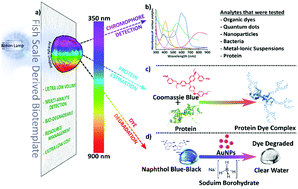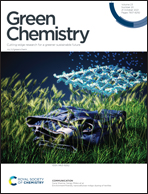A sustainable transparent biotemplate from fish scale waste for ultralow volume high-sensitive UV-Vis spectroscopy†
Abstract
UV-Vis spectroscopy is a versatile analytical tool used to examine the nature of various synthetic, biological and clinical molecules for pharmaceutical and environmental applications. The analysis is typically performed in a “cuvette or microplate” that is made of either high-priced quartz or eco-unfriendly plastic materials. Besides, cuvettes and microplates require a plethora of analyte volumes between 100 μL–5 mL that is unfeasible for expensive, rare and high-risk analytes. Herein, we have developed a low-cost sustainable biotemplate derived from fish scales for analysing the absorbance of various sub-10 μL analytes. Naturally acquired transparency enabled optical transmittance above ∼80% in the broad visible and near IR spectrum of 350–900 nm permitted accurate measurements. Most importantly, droplet retention over 30 minutes against gravity with the vertically aligned biotemplate supported such ultra-low volume measurements as well as monitoring of chemical reactions in situ. Moreover, the non-impregnated analyte droplets could be retrieved post-analysis due to the marginally porous hierarchically layered hydrophilic biotemplate with a contact angle of 79°. A customized reusable low-cost 3D-printed adapter was fabricated to position the biotemplate inside the cuvette slot. The biotemplate exhibited excellent compatibility to detect diverse chromophores such as organic dyes, bacteria, nanoparticles, quantum dots, proteins and metallic suspensions by revealing their corresponding absorbances. As a proof-of-concept, we demonstrated the on-biotemplate catalytic dye degradation analysis with an R2 value of 0.98, and the BSA standard assay to quantify as low as 50 μg mL−1 proteins with comparable sensitivities to that of microplate and quartz cuvettes. Finally, large-scale production has been demonstrated by generating ∼3000 biotemplates at an economical price of only Rs. 106 ($1.44). This ultralow-cost, plastic-free, use-and-throw biodegradable transparent biotemplate prepared from food waste as a bioresource stratagem has huge potential in routine scientific and pharmaceutical UV-Vis analytics.



 Please wait while we load your content...
Please wait while we load your content...